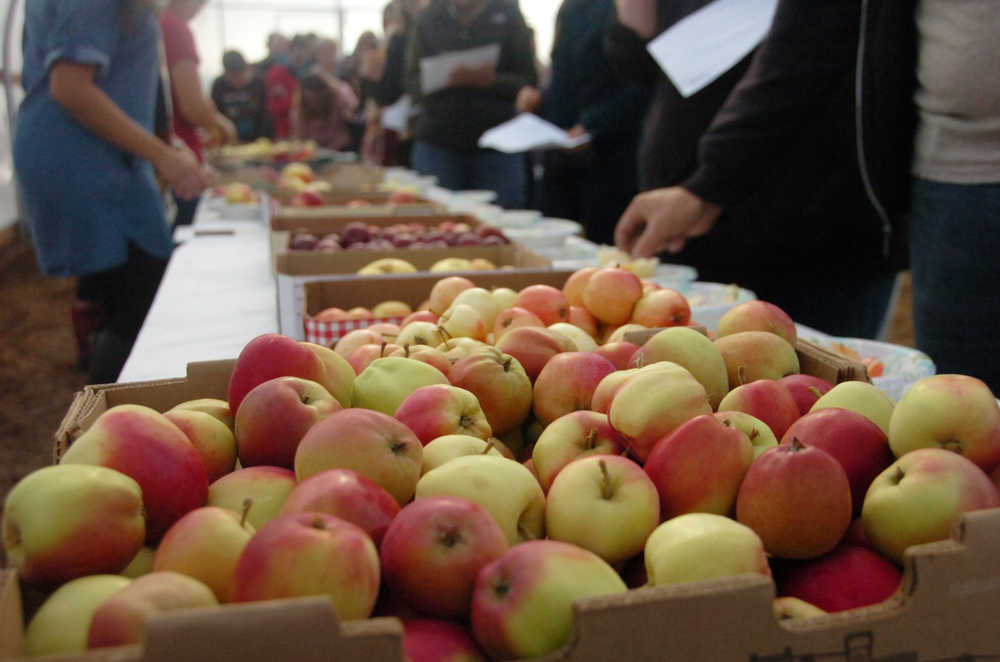A bushel of people waited patiently in line on a chilly Sunday afternoon to get a taste of the apples at O’Brien Garden and Trees in Nikiski.
The O’Briens, who grow cherries, raspberries, strawberries, rhubarb and more in addition to apples, collected evaluation sheets from tasters and allowed people to explore their 10-acre garden from 2-4 p.m. Sunday’s tasting marked the second one this season and was held for the second year in a row at the family’s new location, where they transitioned after a moose problem in 2006 left their original orchard in poor shape.
The tasting events have continued to grow since they began in 1991, said Michelle LaVigueur, daughter of owner Mike O’Brien.
“People are becoming more aware that we’re here first of all, and that you can grow apples in Alaska, which is quite a feat,” LaVigueur said.
For $5, visitors from around the peninsula could sample several apple varieties in one of the farm’s high tunnels, scoring each on a scale of one to 10. A juice-making station was set up at the back of the tunnel, where visiting kids tried their hand at turning apples to juice, which was sold for $1 per cup.
The evaluation scores are essential for O’Brien, who uses them to inform which varieties to focus on in the coming season, he said. Each apple variety receives a score based on the average from all the evaluation sheets.
“That will tell us what we want to propagate in the spring,” O’Brien said. “We can’t say, generally, ‘I like this apple.’ Well, maybe I do, but not everyone is going to agree with that with their taste buds. So when we go ahead and do that, we’re hitting the collective, common thought of, ‘what are the best?’”
Another goal of the tasting is to spread the word about the reality of growing foods in Alaska, LaVigueur said. Seeing the process and the rewards for oneself is often more effective than being told, and LaVigueur said that is exactly what people get exposed to at the tasting.
The myth that apples cannot be grown in Alaska is false, she said. Rather, growers need to take different approaches when working with the soil and environment to get the best results.
“We trial a lot of different varieties, and even in the beginning (my dad) had to trial a lot of different root stock, is what we call it, and it’s just the root of the tree,” LaVigueur said. “Once we found one that was hardy enough for our area, then it opened up the possibility of more variety. When you take an eating variety and put it on the right root stock, because the energy is stored in the root for winter, it makes it to where the whole tree can survive.”
With the help of the evaluations, O’Brien also eliminates fruit varieties that aren’t performing well or aren’t up to his high standards, making room for better products.
“A lot of places that do propagating aren’t considering places like Alaska because it’s a low demand. Why should they bother?” O’Brien said. “In this case, we not only propagate, but we grow and we eat our own (fruit), so we want the best. I mean, if something is OK, well we’ll drop it.”
Robert Gibson, director for the Kenai Peninsula Chapter of the Alaska Farm Bureau and member of the Central Peninsula Garden Club, has attended the garden’s apple tasting events for the last three years. Gibson enjoys learning about different fruit varieties as well as the latest innovations and initiatives to grow on the peninsula, he said.
“I like to see that more and more people are interested in locally-grown foods, which is near and dear to me, being in the Farm Bureau,” he said.
In addition to being educational, the apple tasting is an opportunity to entice residents to take up apple and fruit growing in their own lives, LaVigueur said. O’Brien Garden and Trees expands a little each year, and soon the production will be such that the O’Briens will begin to seek out retail buyers in addition to frequenting local markets, she said. They are also working to repair the original garden site, which will reopen when the trees are ready, O’Brien said.
The O’Brien’s will host a winter apple tasting on Oct. 4, which will feature later-developing fruits such as Granny Smiths and Honeycrisps, O’Brien said.
“Of course those will be the ones that store the best,” he said. “The later that they ripen, generally speaking they store longer. Winter apples will be the holdover for winter and you’ll be eating those in the spring. Honeycrisp will last five months in common refrigeration.”
Reach Megan Pacer at megan.pacer@peninsulaclarion.com.

